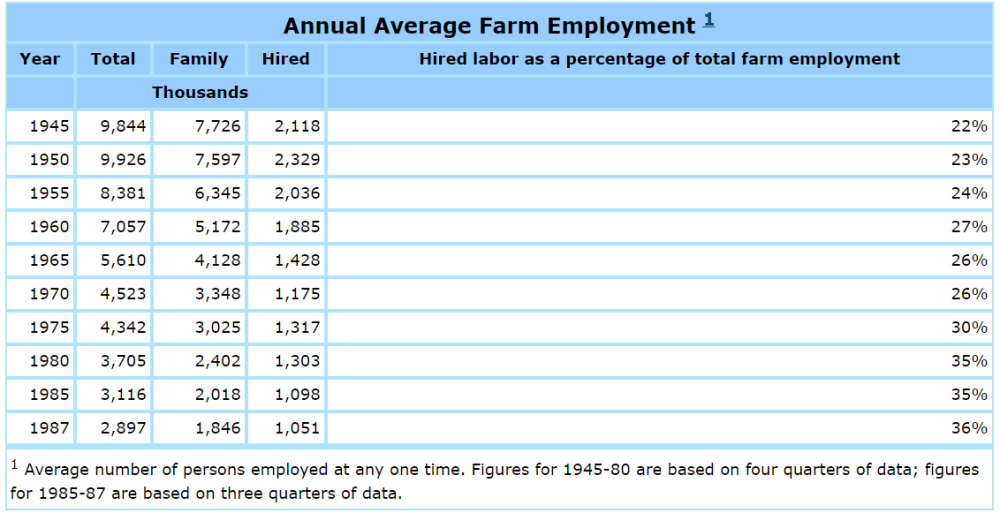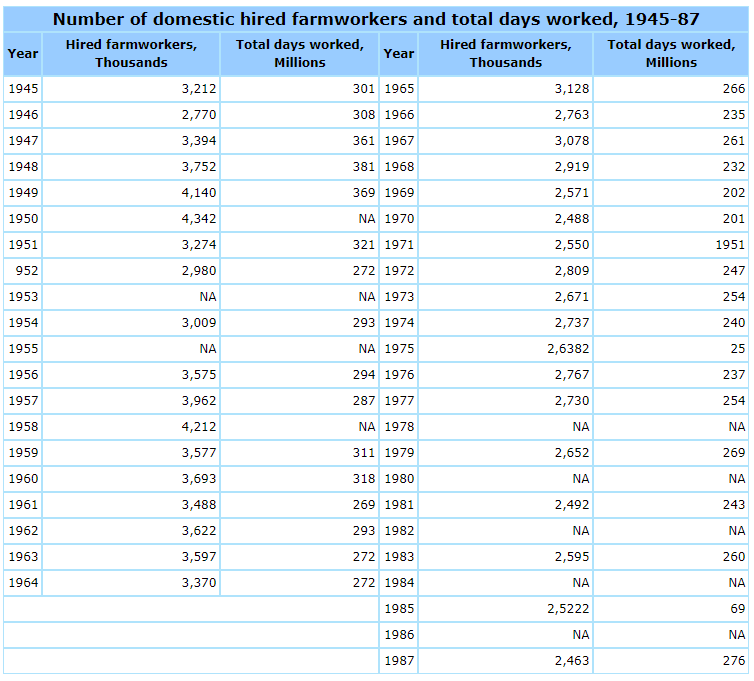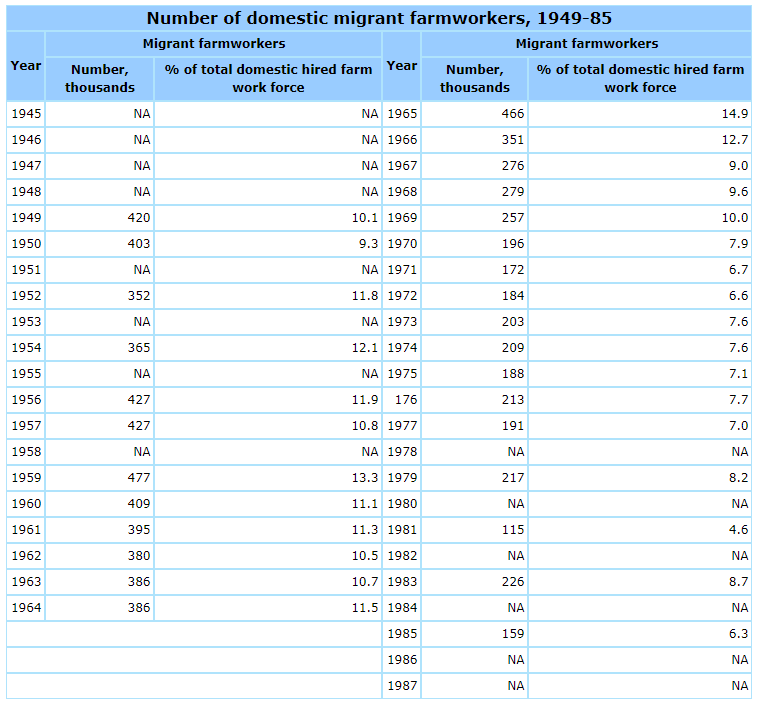Average employment in US agriculture declined by 75 percent between 1945 and 2020, from almost 10 million to less than 2.5 million. The hired worker share of average employment in US agriculture doubled from a third to two-thirds over this 75-year period.
During the four decades between 1945 and the late 1980s, the number of farm operators and unpaid family workers fell faster than the number of hired workers. The hired worker share of average agricultural employment rose from less than a quarter to over a third.
The hired worker share of average employment rose between 1945 and 1987.

Beginning in 1945, the Current Population Survey included a December supplement that asked if anyone in the household did farm work for wages during the year. USDA tabulated these data on hired farm workers in its Hired Farm Workforce reports.
The total number of hired farm workers was 3.2 million in 1945, when the average employment of hired workers was 2.1 million, suggesting 1.5 workers for each average job. The number of hired workers rose to 4.3 million in 1950 and was 4.2 million in 1958, and then declined to 2.5 million in the 1980s. Average employment was 2.3 million in 1950 and 1.9 million in 1960, suggesting 1.7 and 2.2 workers for each average job, respectively. The average days of farm work declined in the 1950s due to rising seasonality and turnover.
The number of hired workers fell from 3.2 million in 1945 to 2.5 million in 1987, down 22 percent, while the number of days worked by hired workers fell from 301 million to 276 million, down eight percent. During the 1970s and 1980s, the number of hired workers was stable at 2.6 million. The total days of farm work reported by hired workers rose from 200 million to 275 million in the 1970s and 1980s.
Seasonality increased in the 1960s days worked fell faster than the number of workers.

The number of domestic migrant farm workers, defined by USDA as persons who crossed county lines and stayed away from a usual home at least one night to do farm work, peaked at 477,000 in 1959. The number of migrants dropped almost 20 percent before increasing to 466,000 in 1965 as farm employers recruited US workers after the end of the Bracero program. The share of US farm workers who were migrants peaked in 1965 at 15 percent.
The migrant share of US hired workers peaked in 1965 at 15 percent.

Legal foreign guest workers were also employed in US agriculture. Most of the guest workers between 1945 and 1964 were admitted under several Bracero programs, including a wartime 1942-47 program that involved the US government recruiting and transporting Mexican guest workers, a 1948-50 program under which US farm employers recruited and transported Mexican guest workers, and the main 1951 PL-78 program that ended in 1964. A separate H-2 program was created in 1952, renamed H-2A in 1986, and admitted mostly guest workers from Caribbean islands until the mid-1990s, when Mexico became the main country of origin.
The number of foreign guest workers peaked in 1956 at almost 460,000, and declined rapidly after 1964. Bracero data are admissions, so a worker returning year-after-year is counted each year that he returns. H-2 and H-2A data are the number of farm jobs certified by DOL to be filled with foreign workers. Certifications reached a low of 12,500 in 1972 before almost doubling to 22,600 in 1987.
Most foreign guest workers were admitted under the Bracero program until 1964.

The US Border Patrol recorded the industry where unauthorized foreigners were employed when they were apprehended inside the US. The Border Patrol apprehended fewer than 25,000 farm workers a year until the Bracero program ended in 1964. Apprehensions of unauthorized farm workers rose to a peak of almost 125,000 in 1975 before falling to less than 10,000 in 1986, when the Immigration Reform and Control Act that included an amnesty for unauthorized foreigners who had done farm work in 1985-86 was enacted. IRCA largely ended Border Patrol enforcement in US agriculture.
The number of unauthorized workers apprehended while employed in agriculture peaked in 1975.

Author


Mexico Institute
The Mexico Institute seeks to improve understanding, communication, and cooperation between Mexico and the United States by promoting original research, encouraging public discussion, and proposing policy options for enhancing the bilateral relationship. A binational Advisory Board, chaired by Luis Téllez and Earl Anthony Wayne, oversees the work of the Mexico Institute. Read more

Explore More
Browse Insights & Analysis
360° View of How Southeast Asia Can Attract More FDI in Chips and AI




